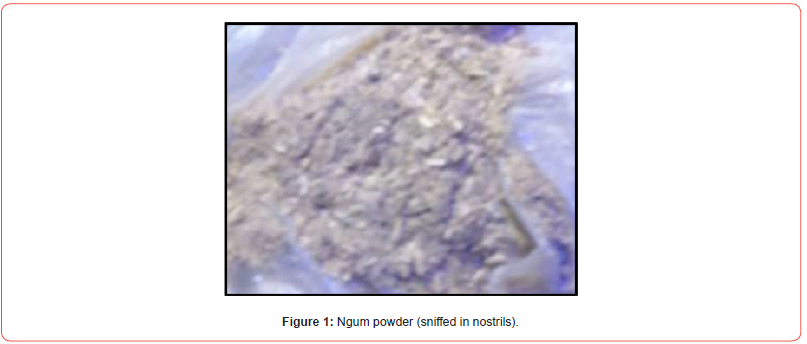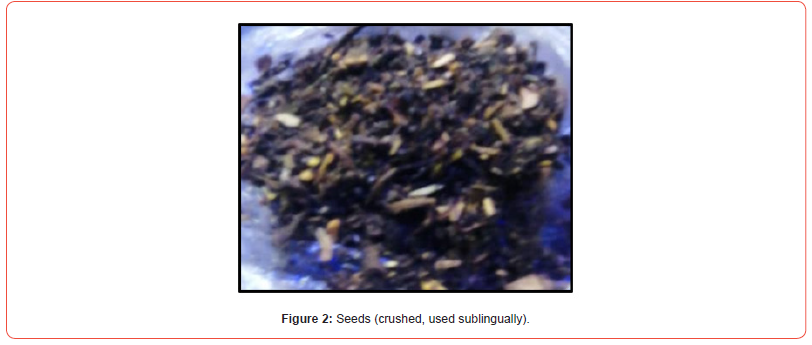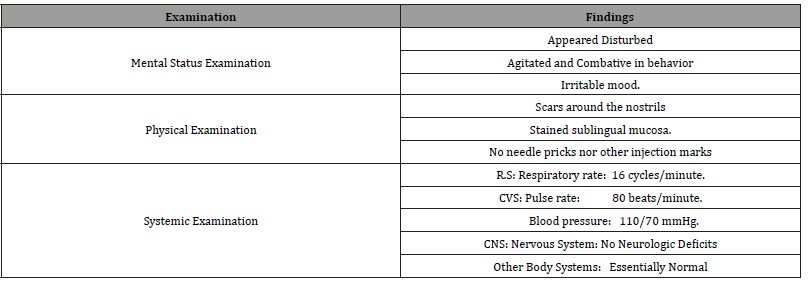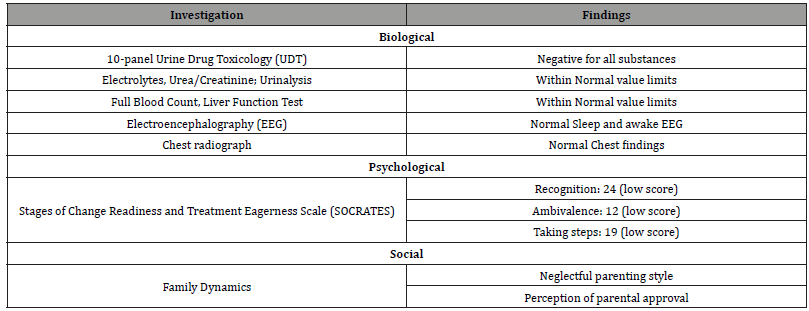 Case Report
Case Report
A Case Report of An Adolescent Dependent on Multiple Unspecified Chemicals: An Evolving Trend in Substance Abuse
Yesiru A Kareem1,2*, Placidus N Ogualili1, Umar B Musami1,3, Fatai A Kareem4, Nasir M Sani1 and Tajudeen O Abiola5
1Department of Mental Health, Drug Abuse Treatment and Rehabilitation Unit, Federal Neuropsychiatric Hospital, Maiduguri, Borno State, Nigeria
2Department of Forensic Psychiatry, Directorate of Clinical Services, Neuropsychiatric Hospital, Aro, Abeokuta, Ogun State
3Department of Mental Health, Faculty of Clinical Sciences, College of Medical Sciences, University of Maiduguri. Borno State
4Department of Science Laboratory Technology, School of Science and Technology, Gateway ICT Polytechnic, Saapade. Ogun State
5Department of Clinical Services, Federal Neuropsychiatric Hospital, Barnawa, Kaduna State
Kareem Yesiru Adeyemi, Drug Abuse Treatment and Rehabilitation Unit, Department of Mental Health, Federal Neuropsychiatric Hospital, Maiduguri, Nigeria.
Received Date:January 22, 2024; Published Date:January 31, 2024
Abstract
Background: In the modern day, addiction is evolving into complicated presentations.1 A fifteen-year-old youngster who started misusing
strange psychotropic drugs is the subject of this case. The boy’s distinct drug use and demeanor make diagnosis and therapy challenging. His father
gave his permission for him to write this case report while the boy gave his assent.
Aim: To overcome the diagnostic obstacles, this case study attempts to outline the new advances in substance use.
Methods: By using targeted assessments, organizing relevant data, and summarizing the circumstances, the report was prepared.
Case Presentation: A 15-year-old boy was diagnosed with a dependency on psychoactive substances and was admitted to a detoxification
unit. A family-based approach was adopted, and drug use charts were used to monitor his condition. After stabilization, rehabilitation was initiated,
and his condition improved significantly with improved clinical and psychosocial outcomes. His diagnosis was “Disorder due to use of unknown or
unspecified Psychoactive substances.”
Conclusion: Substance abuse is a growing trend among adolescents mixing non-specified substances, thus necessitating more explorations.
Parents should adopt a favorable parenting style that aids communication, while healthcare workers require a high degree of suspicion for timely
Management.
Keywords:Adolescent; Dependence; Evolving; Trend; Unspecified Psychoactive Substances
Introduction
Addiction has become a complex presentation in recent times [1] especially among the young age group [2]. This is a case report of an adolescent who started using some unusual psychoactive substances at the age of fifteen, with uniqueness in the usage and his presentations posing diagnostic and management challenges.
He assented to write this case report, while his father consented. He presented three years of use of a cocktail of ‘Ngum’, a volatile substance of different brands (Yar Benisheik, Potiskum, and Maiduguri), mixed with the soot of burnt tyres (a toluene-based adhesive) for 2 years duration (Figures 1 & 2).


He also occasionally inhaled pit latrine vapors to get ‘high’. He had two episodes of convulsion on missing the substances. The father also noticed excessive restlessness, undue anger outbursts, and assaultive behavior in the last two months, during which the ‘Ngum’ intake was accelerated. There were features of dependence: a sense of compulsion to take a substance, tolerance to the effects of the substance, loss of control of substance-taking behavior, and preoccupation with substance use for the last 2years to presentation. No use of alcohol nor other (psychoactive) substances but had convulsions of two episodes (Tables 1 & 2).
Table 1:Examination.

Table 2:Investigations.

Differential Diagnoses
Using the ICD-11 Clinical Description and Diagnostic Guidelines
(CDDG) [2].
1. Disorders due to use of volatile inhalants with volatile
inhalant-induced psychotic disorder.
2. Disorders due to use of non-psychoactive substances
3. Substance-induced seizure disorder.
5. Management
A final Diagnosis was made of Disorders due use of unknown or unspecified Multiple Psychoactive substances, current use. A severity risk assessment was done using the Psychopathy Check List – Revised version (PCL-R). On account of the risk of harm to self and others, he was admitted into the Drug Addiction Treatment, Rehabilitation and Education (DATER) unit for the Management of substance dependence with psychosis. After the stabilization with parenteral antipsychotic, Pharmacological detoxification commenced with Tabs Carbamazepine and Tabs Risperidone for psychosis. A brief course of supportive psychotherapy was employed by the Child Psychologist, which included analyzing the consequences that followed the misuse, as well as the positive and negative sequelae of drug usage. To aid in the recognition and reduction of cravings, a family-based approach and patient-centered therapy were used. Social workers were invited to make brief interventions to aid him in achieving a behavioral change, as well as to monitor progress and offer encouragement and assistance in rebuilding his life [3]. To avert potentially dangerous circumstances and avoid risky situations, drug logs were created, which indicated when he took the substances and when he abstained.
Conclusion
Following the treatment, there was a decrease in the frequency of volatile substance usage, as well as a decrease in the desire for volatile substances. Also, the general debilitation improved, and rehabilitation was initiated based on the patient’s short- and longterm goals. He has been visiting the Rehabilitation clinic regularly, and his overall condition has improved significantly with favorable clinical and psychological outcomes.
Acknowledgement
None.
Conflicts of Interest
No Conflict of Interest.
References
- Luethi D, Liechti ME (2020) Designer drugs: mechanism of action and adverse effects. Arch Toxicol 94(4):1085-1133.
- (2022) World Health Organization. New International Classification of Diseases (ICD-11) comes into effect.
- Köck P, Meyer M, Elsner J, Dürsteler KM, Vogel M, et al. (2022) Co-occurring Mental Disorders in Transitional Aged Youth with Substance Use Disorders - A Narrative Review. Front Psychiatry 13: 827658.
-
Yesiru A Kareem*, Placidus N Ogualili, Umar B Musami, Fatai A Kareem, Nasir M Sani and Tajudeen O Abiola. A Case Report of An Adolescent Dependent on Multiple Unspecified Chemicals: An Evolving Trend in Substance Abuse. Glob J Aging Geriatr Res. 2(5): 2024. GJAGR. MS.ID.000547.
-
Adolescent Dependent, Multiple Unspecified Chemicals, Unspecified Psychoactive Substances, Adolescent, Evolving, Trend
-

This work is licensed under a Creative Commons Attribution-NonCommercial 4.0 International License.






